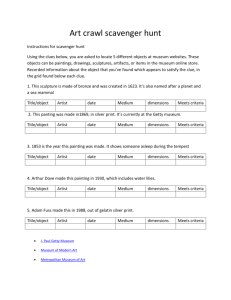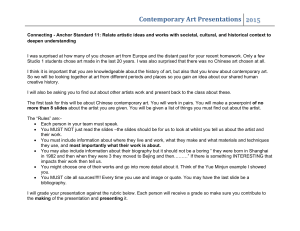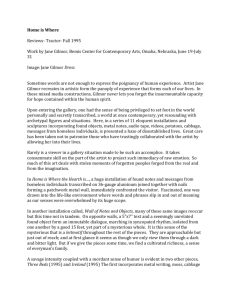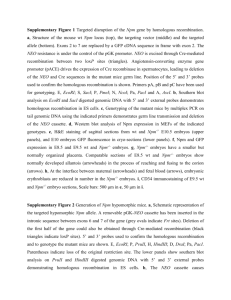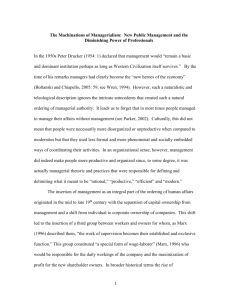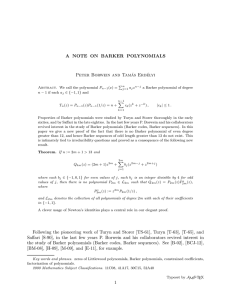The National Palace Museum, one of the four world famous
advertisement
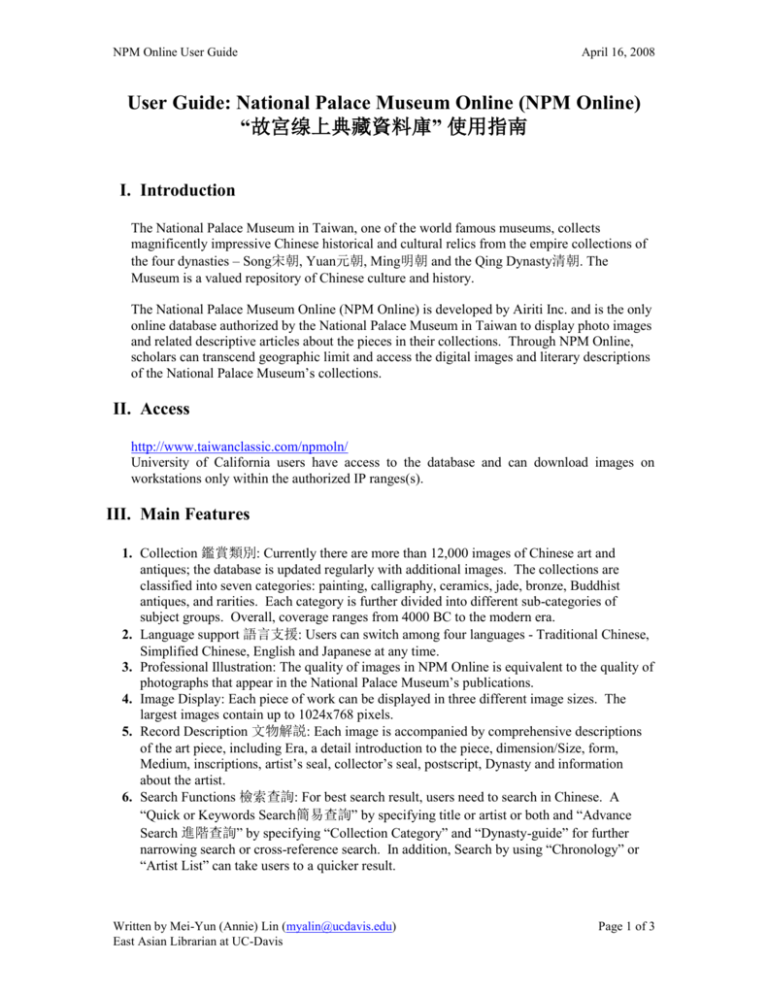
NPM Online User Guide April 16, 2008 User Guide: National Palace Museum Online (NPM Online) “故宮缐上典藏資料庫” 使用指南 I. Introduction The National Palace Museum in Taiwan, one of the world famous museums, collects magnificently impressive Chinese historical and cultural relics from the empire collections of the four dynasties – Song宋朝, Yuan元朝, Ming明朝 and the Qing Dynasty清朝. The Museum is a valued repository of Chinese culture and history. The National Palace Museum Online (NPM Online) is developed by Airiti Inc. and is the only online database authorized by the National Palace Museum in Taiwan to display photo images and related descriptive articles about the pieces in their collections. Through NPM Online, scholars can transcend geographic limit and access the digital images and literary descriptions of the National Palace Museum’s collections. II. Access http://www.taiwanclassic.com/npmoln/ University of California users have access to the database and can download images on workstations only within the authorized IP ranges(s). III. Main Features 1. Collection 鑑賞類別: Currently there are more than 12,000 images of Chinese art and antiques; the database is updated regularly with additional images. The collections are classified into seven categories: painting, calligraphy, ceramics, jade, bronze, Buddhist antiques, and rarities. Each category is further divided into different sub-categories of subject groups. Overall, coverage ranges from 4000 BC to the modern era. 2. Language support 語言支援: Users can switch among four languages - Traditional Chinese, Simplified Chinese, English and Japanese at any time. 3. Professional Illustration: The quality of images in NPM Online is equivalent to the quality of photographs that appear in the National Palace Museum’s publications. 4. Image Display: Each piece of work can be displayed in three different image sizes. The largest images contain up to 1024x768 pixels. 5. Record Description 文物解説: Each image is accompanied by comprehensive descriptions of the art piece, including Era, a detail introduction to the piece, dimension/Size, form, Medium, inscriptions, artist’s seal, collector’s seal, postscript, Dynasty and information about the artist. 6. Search Functions 檢索查詢: For best search result, users need to search in Chinese. A “Quick or Keywords Search簡易查詢” by specifying title or artist or both and “Advance Search 進階查詢” by specifying “Collection Category” and “Dynasty-guide” for further narrowing search or cross-reference search. In addition, Search by using “Chronology” or “Artist List” can take users to a quicker result. Written by Mei-Yun (Annie) Lin (myalin@ucdavis.edu) East Asian Librarian at UC-Davis Page 1 of 3 NPM Online User Guide April 16, 2008 7. Chronology 藝術年表: Collections of NPM Online are displayed chronically in Chinese and Christian eras. By pointing at the Christian year, users can see the Chinese years by Dynasty. 8. Artist List 書畫家名錄: From “Painter list” and “Calligrapher list” users can click on the name of artist and find the specific artist’s works quicker. IV. Search Examples Option 1: Quick or Keywords search簡易查詢 1. From home page, click on “Advance Search進階查詢” on the top, you will see both “Quick or Keywords search簡易查詢” on the left panel and “Advance search進階查詢” on the right panel. 2. Key in “李公麟” and specify both title and artist on the “Quick or Keywords search簡易查 詢” box, then enter. 3. There are 3 results that are classified in “painting” category, from Song dynasty, and are indexed in Dynasty, artist’s name, and name of work. 4. Click on “麗人行” of art piece, you’ll see the image with detail description of this work. For a larger image view, click on the “enlarge” icon under the image, then, you can print this image or click on “close” to close this window. Click on the “envelop” icon under the image, you can email this image as a postcard to someone. Click on “add to my collection” icon, you can save it to your file. Click on “李公麟”, you will receive more works of this artist. Click on “宋朝”, you will see all art works of Song dynasty from NPM Online. Option 2: Advance Search 進階查詢 1. If you like Embroidery of Plums and Bamboos, but you don’t know the name of art piece, or the artist, or the period of art work; you can key in “梅竹” on the “Keyword關鍵字” search box, and select “silk tapestry 緙綉” from “collection or subject category文物類別” and enter. 2. You will receive one result. Then, you can click on the image, “繡梅竹山禽圖.” 3. You will see the image with many features as number 4 of Option 1. Option 3: Search by “Collection subject category鑑賞類別” 1. On the left panel under the “Quick or Keywords Search簡易查詢”, click on each collection subject category, sub-categories of subject groups will appear. 2. For example, you are looking for image on Buddhist work. Select “Buddhist 佛教文物,” then, click on “Buddhist painting 佛教畫.” 3. Click on the image of “ Kuan-yin of a Thousand Arms and Eyes畫千手千眼觀世音菩薩,” you will see the image with many features as number 4 of Option 1. Option 4: Search by using “Chronology藝術年表” 1. If you want to view all art pieces from 4000 AD period, you can point on -4000 Christian era. 2. The system will show three periods of Chinese eras under 4000 AD, click on these. Then, click “All” under “Shang” period from the chart. 3. You will receive 8 pages of art works from “Shang” period, click on any image. 4. Again, you will see the image with many features as number 4 of Option 1. Written by Mei-Yun (Annie) Lin (myalin@ucdavis.edu) East Asian Librarian at UC-Davis Page 2 of 3 NPM Online User Guide April 16, 2008 Option 5: Search by using “Artist List書畫家名錄” 1. Use this search function to browse on all the name of artists included in NPM Online either by painter’s name or calligrapher’s name or by both. 2. Click on “管道昇” under “元朝” for example, you will receive one image. Click on this image “煙雨叢竹.” 3. Again, you will see the image with many features as number 4 of Option 1. It is important that you log off from this database at the end of your search. Additional Note: Request for Inter-Library Loan (ILL) from a non-UC institution must be tracked for a report to Airiti. This is a condition within the current Airiti agreement. It is important to count requests for image coming directly to you from non-UC institutions. Annie Lin will need to report the counts from you and your library's ILL staff for the period of April 2008 through December 2008. Written by Mei-Yun (Annie) Lin (myalin@ucdavis.edu) East Asian Librarian at UC-Davis Page 3 of 3





